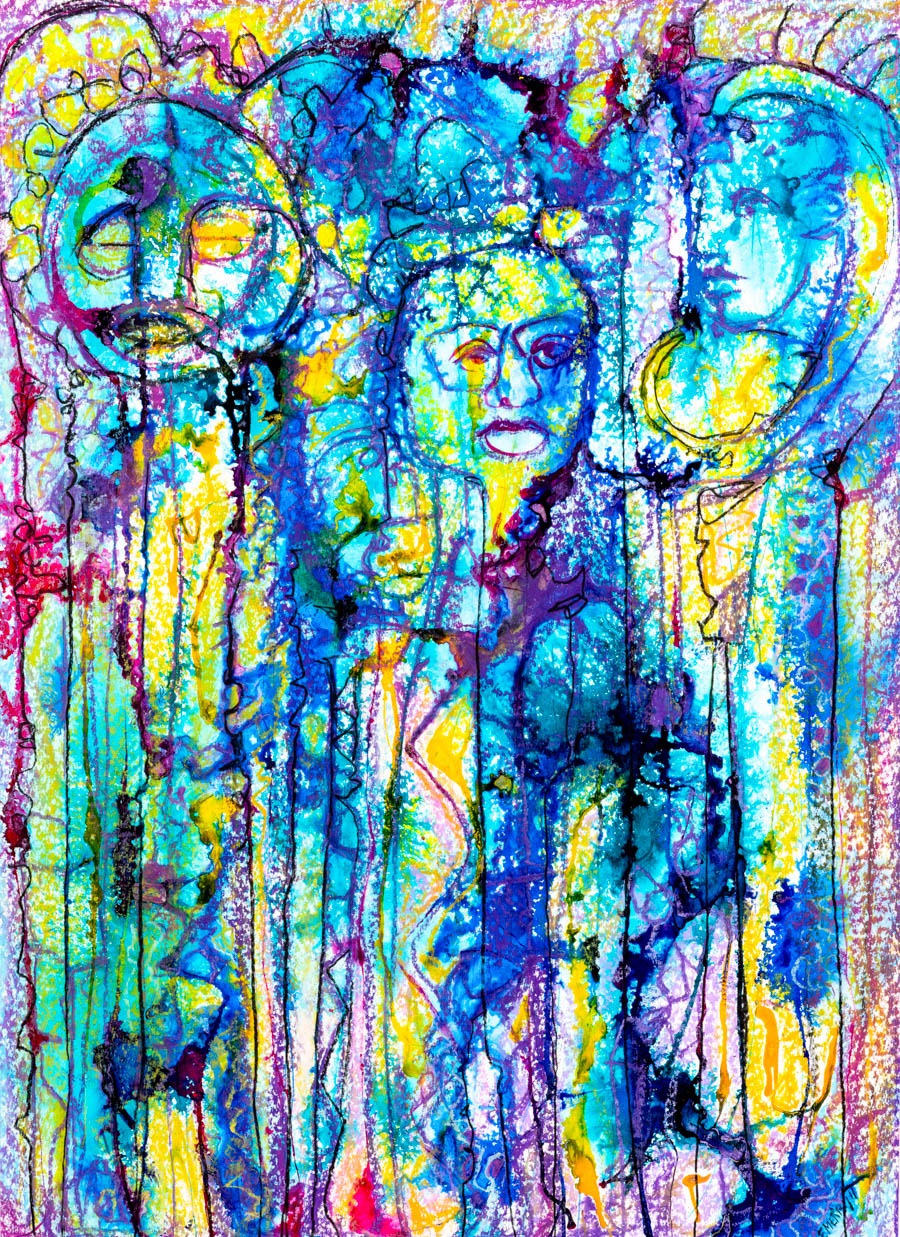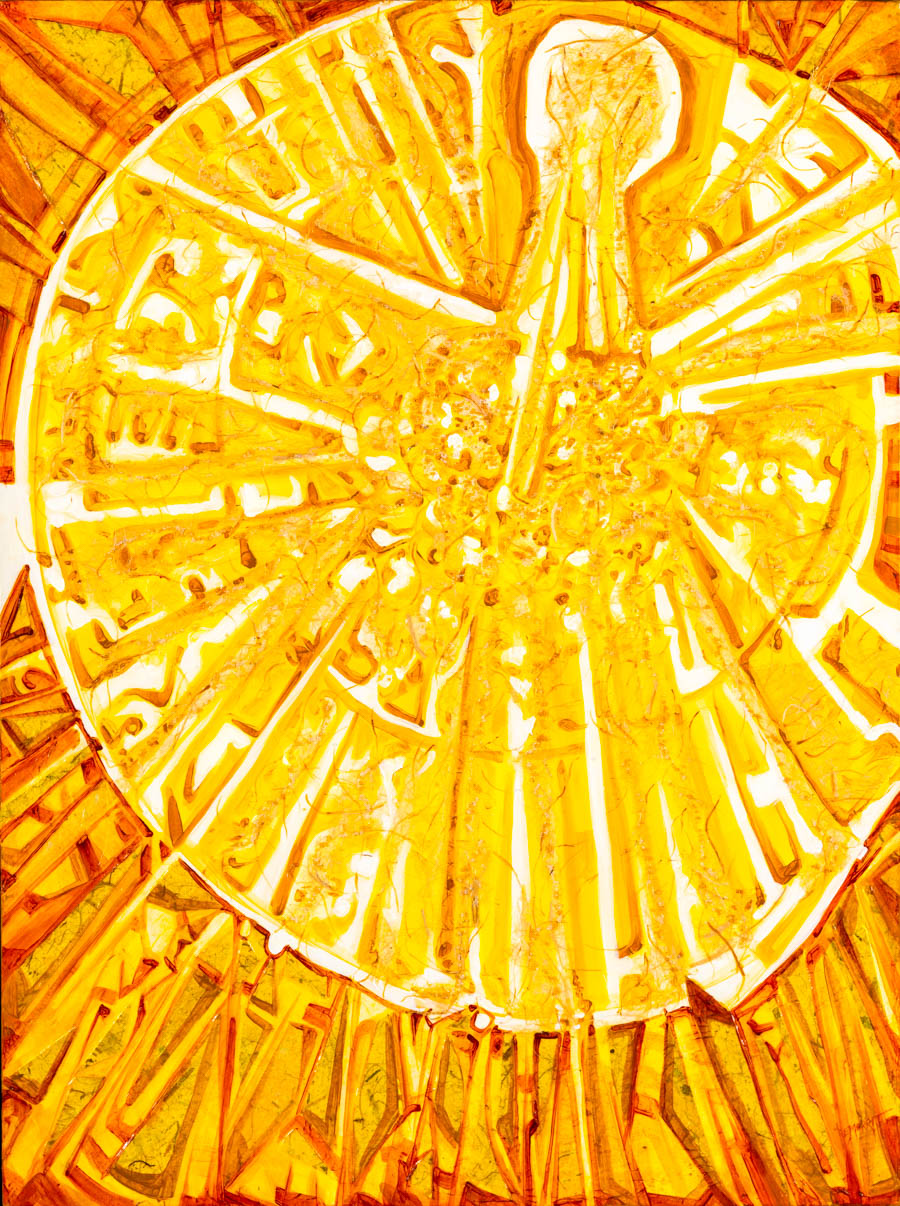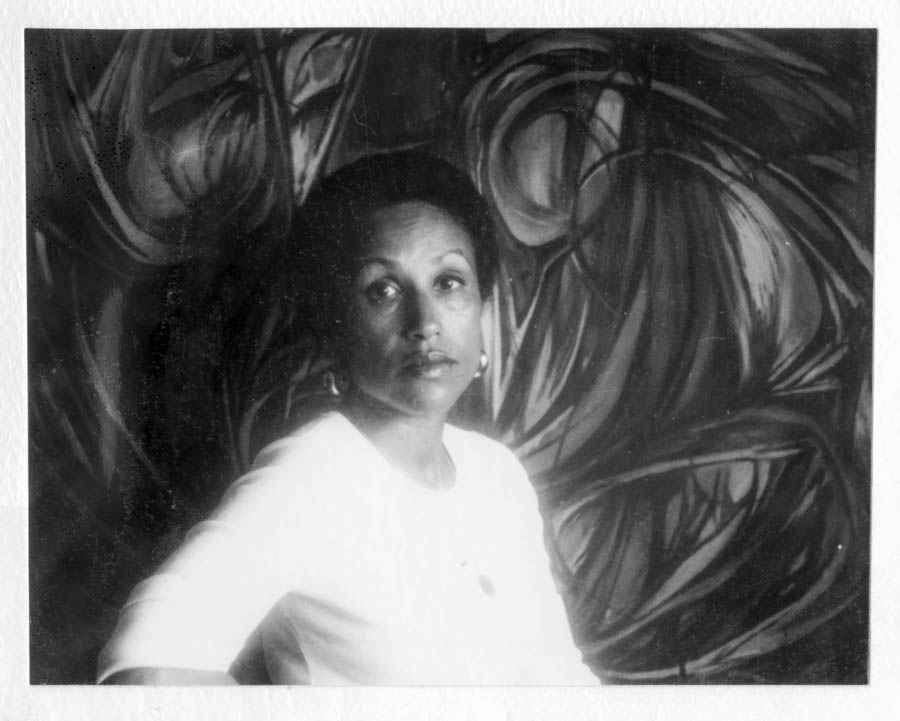Dr. Lisa Merritt remembers talking with her mother about “One day . . .” This was before the Merritt matriarch’s passing in 2019 but after the lung cancer diagnosis a dozen years prior and Eleanor Merritt was still painting, through the pain and through a terrible knowing—that her story would end a certain way. She had come to accept that her breakout as an artist would likely not happen in this life, so she and her daughter would talk about that mythical “one day” instead, when the rest of the world would catch on to what these two already knew in their hearts to be true—that Eleanor Merritt was a master artist. “I promised her we would have an exhibition,” Lisa says today. And with Remembrance, currently on exhibition at the Ringling Museum, she fulfills that promise. It wasn’t easy.

ELEANOR MERRITT, 'REMEMBRANCE', MIXED MEDIA ON PAPER
An artist’s legacy can be difficult to parse and there’s a reason some people make a profession out of doing so. In Eleanor Merritt’s case, her legacy lay sprawled across near seven decades of unceasing activity. From her time as a rising star at the High School for Music and Art and Brooklyn College to her years on the Suncoast, Merritt never seemed to stop moving and building. She taught art for 27 years in Long Island, became the first African-American chair of the District Art Department and was an early member of the Long Island Black Artist Association and co-founded the Women of Color of Art. She traveled the world in search of inspiration and brought it back to Sarasota, where she served on the board of the arts council and The Ringling Museum, served as president of the Venice Art Center and became a member of the Florida Artists Group, Women Contemporary Painters and the Petticoat Painters. She was an educator, a community leader, an administrator and even a volunteer docent for 25 years. And for almost 70 years, she never stopped painting.

ELEANOR MERRITT, 'HERE COMES THE SUN', MIXED MEDIA WITH BEADS
Much of the work, Lisa could recall in some form or another. She grew up helping her mother hang shows and remembers carting paintings around town for delivery or display. Sometimes she even sat for her mother’s paintings, absorbed into her creative process, and will still refer to some of those early works as her “brothers and sisters.” Imagine her surprise at finding a whole bunch of siblings she never knew she had, when the initial accounting of Merritt’s studio unearthed a substantial additional body of work that no one had ever seen. “It just made me love her even more, if that was even possible,” Lisa says. Stored in unassuming racks like so much loose material and scrap resources, entire studies were squirreled away, iterations and variations on a theme showing an artist in full exploration mode. Luckily for its discoverers, Merritt also kept meticulous notes. “She was extremely fastidious in documenting her work,” Lisa says, and that included not only organizing the drawings and paintings themselves, but keeping track of her sales and correspondence with collectors, writing notes on the stories behind individual pieces and making sure that the medium and its message were never easily parted. “She was self-curating,” Lisa says. “It makes you further grasp the range of who she was.”
But grasping the entirety of her mother’s legacy still proved elusive. Enter Mike Solomon, a celebrated artist with more than 30 years of experience in navigating and evaluating artist estates, including that of his father, Syd Solomon. “Relatives of artists always think they’re great,” says Solomon, and it’s his job to determine if they’re right. Delving into an artist’s estate, Solomon not only catalogs what can be found in the studio or in the galleries but seeks out as much of their work as he can find, wherever it may be. In collections, on magazine covers, in one-off shows and strange forgotten corners where only a helpful signature on the canvas remembers the hand that made it. He wants it all. And through the entirety of his evaluation, he holds one question at the forefront: Does the work transcend the personal story? “It has to,” Solomon says. In his initial survey, Solomon found about 200 different works of art to Merritt’s name—and only about half of that did the Merritt estate have control over or even know where they were. “It’s four or five times that now,” says Solomon, as two more years of investigation continued to uncover more and more from the artist that wouldn’t quit. But Solomon had already seen enough. “I was f*!@ing blown away,” he says. “This was a serious artist with serious chops.”
Surveying the work, Solomon quickly identified at least three to four major styles or modes that Merritt embraced, and for each of them he found 30-50 paintings tracing the artist’s engagement with each idea. “She explored all of them very thoroughly,” he says. “And a show could be done on each of her styles.” He identified clear throughlines in her career—themes and areas of interest that she used her painting to investigate and uncover. Some were topical, such as exploring the power of the human form, the need for humanitarianism and the role of women and especially women of color in history and society. Others were material, evidenced in Merritt’s continual experimentation with new mediums, going from oil to acrylic to conte crayon to mixed media, working on canvas, on cardboard, on paper and even on tapa cloth from Jamaica.
Even Merritt’s earliest work, in high school and college, showed the artist that she would become. “Some people have natural talent, but they cruise on it,” Solomon says. “This was somebody who took that talent and worked very hard, was very disciplined and pushed it as far as they could push it.” In the end, he would arrive at a single conclusion: “Eleanor was a master,” Solomon says. “In every way, she more than qualifies.”
The next step was the Ringling Museum. Over the course of her career, Merritt exhibited all over New York and Connecticut, from the Black History Museum and the Langston Hughes Cultural Center to the University of Connecticut and the Craftery Guild. In Sarasota, her work could be seen in shows at Art Uptown Gallery, Art Center Sarasota and more. The Arts & Cultural Alliance of Sarasota even organized a retrospective in 2016, entitled Sixty Years of Painting: 1957-2017. And she was no stranger to The Ringling Museum, having served on the board and been a popular docent for more than 25 years. But an exhibition was something else entirely.
Lisa went to The Ringling in her mother’s stead, to make the case for her mother’s legacy and propose a solo exhibition. Solomon accompanied. They met with Executive Director Steven High, who knew Eleanor Merritt through her contributions to the museum, and Solomon told him that the museum had an opportunity in front of it—to “discover” a serious artist, right in its backyard, long overdue for recognition. High said he would curate the exhibition himself. On display at The Ringling through August, Remembrance gives viewers an abbreviated journey through Merritt’s prolific career, using 22 paintings to highlight styles, themes and important works.
“A show could be done on each one of her styles,” says Solomon, who performed the initial curation with Lisa, before handing the project over to High. The earliest piece, Untitled, comes from 1950, when Merritt was still in school and only 17, showcasing the talent that so stood out. And paintings like Metamorphosis aka Transformation, Corn Goddess and Remembrance highlight the artist’s singular blend of abstraction and figurative work, something that Solomon was sure to include. “It’s a particular genre that is just fascinating,” he says. “And I wanted several of them.” He was just as adamant about including Merritt’s Spirit Catcher and Mourning, Soweto Series, both of which were made with conte crayon and evince an aesthetic both decidedly Merritt yet distinct from her other works. “That’s an area of work that really needs to be looked at,” says Solomon. “She was an unbelievable drafts-woman and those show it the best.”
Other paintings have more personal stories that only a daughter would know. Lori Merritt remembers when her mother made Angel of Mercy 911 in 2001, acrylic on tapa cloth. “That got her to her core,” she says. And Lisa will always remember the self-portrait her mother painted in 2007, following her cancer diagnosis, the image fierce and defiant as flame. “It showed her power,” she says. “That her life force was strong.” And she will remember Just Breathe, painted in 2014, when the diagnosis got worse. “She was painting like there was no tomorrow,” Lisa says, and it kept her going. “There’s no doubt.”
Painted in 2018, Blue Embrace is the latest of Merritt’s work to be found in the exhibition, a fitting blend of figurative and abstract, warm despite a blue that could otherwise be chilly, and one of the last marks of a master. After the exhibition comes down in August, three of the paintings will remain with The Ringling as part of the museum’s permanent collection. And the museum has also launched the Eleanor Merritt Fellowship in her honor, a yearly fellowship program for recent college graduates from populations under-represented in arts administration, who have an interest in curatorial arts or arts administration. From there, there are tentative plans for future exhibitions, traveling shows, maybe even a book. “This exhibition is just the tip of the iceberg,” says Solomon. “And the iceberg is huge.”
But for the sisters Merritt, Remembrance will always hold a special place. “It’s an affirmation of 60 years of artistry,” says Lori. “It’s the opportunity to breathe new life into her artwork.” And weeks after the opening reception in the Ringling Courtyard, Lisa still gets emotional thinking about that moment, facing a crowd gathered to celebrate her mother’s art, which lay just beyond the door to the gallery. “It was an incredibly full moment,” she says. “I felt her spirit with me. “It’s good.”










